In this Feb. 6, 2015 photo, coal miners wait for their ride down the tunnel to start their eight hour shift in Gujiao in northern China's Shanxi province. Chinaâs coal production is estimated by its main industry group to have fallen 2.5 percent last year, the first reduction in two decades. Environmentalists welcomed that as a sign coal use might decline, but it prompted unease about the health of an industry that the Ministry of Land and Resources says employs 10.3 million people. (AP Photo/Ng Han Guan)
The Associated Press
GUJIAO, China (AP) - This city in China's northern coal country hardly looks like it is in trouble. After three decades fueling China's industrial boom, its wide, tree-lined avenues are filled with late model cars. Markets are crowded with people.
That activity masks malaise. Surging demand for coal that once propelled Gujiao and its 200,000 people is ebbing, and along with it the local economy.
"This year is impossible," said Li Qiumei, who sells fruit on the street. Wearing a parka and padded balaclava in the bright winter sunshine, she said her income has fallen by half since last year to about 50 yuan ($8) a day.
Asked when she expects things to get better, Li shrugged and said, "I don't know."
From coal country to the export-driven manufacturing heartland of China's southeast, millions of people are enduring wrenching change. Beijing is trying to replace an economic model that has run out of steam after delivering years of blistering growth based on trade and investment in construction and heavy industry.
The World Bank and other analysts say a shift to service industries and domestic consumer spending is unavoidable if the world's second-largest economy is to keep growing. The change could also help China cope with another cost of its boom: badly polluted air and water.
In Gujiao, 550 kilometers (350 miles) southwest of Beijing in Shanxi province, miner Fu Senjie said he still works the same eight- and 12-hour shifts but his pay has been cut by half compared with two years ago to about 3,000 yuan ($500) per month.
"I have considered switching industries, but right now all industries are bad," said Fu, smoking a cigarette as he sat on his bed in a room he shares in a company dormitory with two other miners.
Nationwide, last year's economic growth fell to a 24 year low of 7.4 percent. President Xi Jinping, invoking an American phrase, has dubbed this the "new normal." The ruling Communist Party this month announced its lowest ever target for annual economic growth at 7 percent, barely half of its explosive peak of 14.2 percent in 2007. The International Monetary Fund expects growth to decline further in coming years.
Conditions are worse in areas that relied on steelmaking and other heavy industries.
Coal mining, which employs 10.3 million people, has been hit especially hard. Consumption of coal declined in 2014 for the first time in 14 years. Shanxi was China's top coal producer last year and reported its slowest growth at just 4.9 percent.
Chinese leaders have promised to generate new jobs by opening more of the state-dominated economy to private business. But they have yet to cut back monopolies and other privileges for politically favored government companies that reform advocates say are a drag on development.
"The progress is modest and gradual, and still quite small compared to what is needed," said RBS economist Louis Kuijs.
One-industry towns such as Gujiao that grew up as centers for manufacturing or mining are expected to develop a mix of retailing, technology, tourism and other businesses.
Gujiao's mayor announced ambitious plans last year to develop "new energy" industries such as solar panel manufacturing. That will be a tall order for a town in an isolated river valley with no background in technology.
Across China, labor tensions have soared as construction companies and manufacturers cut jobs or close.
In Taiyuan, the Shanxi provincial capital and the home of the China Coal Museum, a 47-year-old woman was killed in December when police fought with laid-off workers who were demanding unpaid wages at a construction site.
In southeastern Guangdong province, a wave of factory closures has led to at least 205 strikes or protests by laid-off workers since August over unpaid wages, according to the China Labour Bulletin, a research group in Hong Kong. In many cases police beat and detained protesters.
Fu, a second-generation miner, said he came to Gujiao in 2013 after a two-year course in mining technology in his hometown east of the provincial capital. He said all 270 of his classmates went to work in coal mines.
Fu said the industry in his hometown is so anemic that at some pits two miners share one job, working alternate months. He said one former co-worker in Gujiao got a job in a pharmacy but most see no alternative to mining.
"If I work at the mine, I get a salary," Fu said.
In hopes of encouraging households to spend, Beijing is allowing wages to rise.
Domestic consumption, a pillar of Beijing's plan, accounted for just over half of economic growth last year for the first time, according to government data.
But uncertainty about the future, as well as a need to save for school fees and medical emergencies, prompts many households to avoid spending any pay increases.
"People's consumption is lagging," said Zuo Aijun, a 32-year-old truck driver at a Gujiao mine who has started a string of small businesses on the side.
Five days a week, he works eight hours a day at the mine for 3,000 yuan ($485) a month, then another six hours at his own businesses, making up to 4,000 yuan ($650) on the side.
Zuo is confident his family will do well but realistic about the challenge of encouraging his new customers to spend.
"People feel they need to keep money in their pocket as insurance," he said.
___
AP researchers Fu Ting in Shanghai and Yu Bing and Zhao Liang in Beijing contributed.
In this Feb. 6, 2015 photo, coal miners return to the surface after their eight hours shift at a coal mine in Gujiao in northern China's Shanxi province. Chinaâs coal production is estimated by its main industry group to have fallen 2.5 percent last year, the first reduction in two decades. Environmentalists welcomed that as a sign coal use might decline, but it prompted unease about the health of an industry that the Ministry of Land and Resources says employs 10.3 million people. (AP Photo/Ng Han Guan)
The Associated Press

In this Feb. 6, 2015 photo, coal miners return to the surface after their eight hours shift at a coal mine in Gujiao in northern China's Shanxi province. Chinaâs coal production is estimated by its main industry group to have fallen 2.5 percent last year, the first reduction in two decades. Environmentalists welcomed that as a sign coal use might decline, but it prompted unease about the health of an industry that the Ministry of Land and Resources says employs 10.3 million people. (AP Photo/Ng Han Guan)
The Associated Press
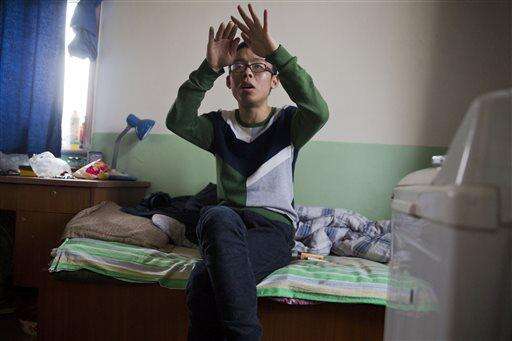
In this Feb. 6, 2015 photo, Fu Senjie talks about his work as a coal miner in Gujiao in northern China's Shanxi province. Two years ago, Fu was paid up to 7,000 yuan ($1,100) a month, working eight- and 12-hour shifts underground in this town in Shanxi province, 550 kilometers (350 miles) southwest of Beijing. But as growth ground steadily lower, coal prices fell, and so did wages. Now, the slender, bespectacled 25-year-old said he works the same hours for half the pay.(AP Photo/Ng Han Guan)
The Associated Press

In this Feb. 6, 2015 photo, Fu Senjie talks about his work as a coal miner in Gujiao in northern China's Shanxi province. Two years ago, Fu was paid up to 7,000 yuan ($1,100) a month, working eight- and 12-hour shifts underground in this town in Shanxi province, 550 kilometers (350 miles) southwest of Beijing. But as growth ground steadily lower, coal prices fell, and so did wages. Now, the slender, bespectacled 25-year-old said he works the same hours for half the pay.(AP Photo/Ng Han Guan)
The Associated Press
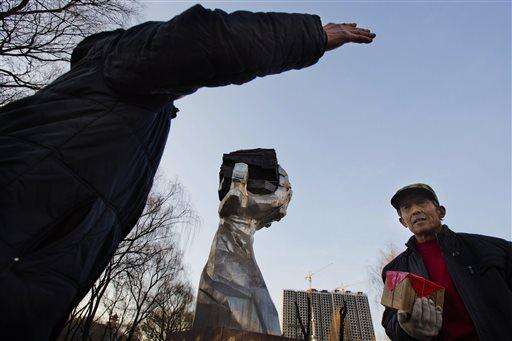
In this Feb. 6, 2015 photo, Chinese men chat near a giant sculpture depicting a hand holding a piece of coal in Gujiao in northern China's Shanxi province. Chinaâs coal production is estimated by its main industry group to have fallen 2.5 percent last year, the first reduction in two decades. Environmentalists welcomed that as a sign coal use might decline, but it prompted unease about the health of an industry that the Ministry of Land and Resources says employs 10.3 million people. (AP Photo/Ng Han Guan)
The Associated Press
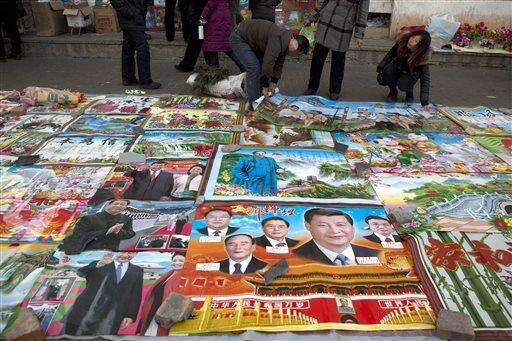
In this Feb. 5, 2015 photo, a vendor attends to customers near Chinese New Year posters featuring Chinese President Xi Jinping and late leader Mao Zedong on a street of Gujiao in northern China's Shanxi province. From coal country to the export-driven manufacturing heartland of Chinaâs southeast, millions of people are enduring wrenching change. Beijing is trying to replace an economic model that has run out of steam after delivering years of blistering growth based on trade and investment in construction and heavy industry. (AP Photo/Ng Han Guan)
The Associated Press

In this Feb. 6, 2015 photo, residents visit a street market in Gujiao in northern China's Shanxi province. From coal country to the export-driven manufacturing heartland of Chinaâs southeast, millions of people are enduring wrenching change. Beijing is trying to replace an economic model that has run out of steam after delivering years of blistering growth based on trade and investment in construction and heavy industry. (AP Photo/Ng Han Guan)
The Associated Press
In this Feb. 6, 2015 photo, children watch as coal miners transport metal parts from a mine in Gujiao in northern China's Shanxi province. Chinaâs coal production is estimated by its main industry group to have fallen 2.5 percent last year, the first reduction in two decades. Environmentalists welcomed that as a sign coal use might decline, but it prompted unease about the health of an industry that the Ministry of Land and Resources says employs 10.3 million people. (AP Photo/Ng Han Guan)
The Associated Press

In this Feb. 6, 2015 photo, coal miners prepare to wash up after their eight hours shift at a coal mine in Gujiao in northern China's Shanxi province. Chinaâs coal production is estimated by its main industry group to have fallen 2.5 percent last year, the first reduction in two decades. Environmentalists welcomed that as a sign coal use might decline, but it prompted unease about the health of an industry that the Ministry of Land and Resources says employs 10.3 million people. (AP Photo/Ng Han Guan)
The Associated Press
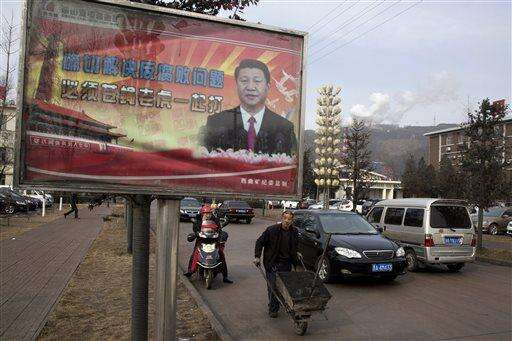
In this Feb. 6, 2015 photo, a motorcyclist uses his mobile phone near a billboard showing Chinese President Xi Jinping with the slogan "To exactly solve the problem of corruption, we must hit both flies and tigers" in Gujiao in northern China's Shanxi province. Chinese leaders have promised to generate new jobs by opening more of the state-dominated economy to private business. But they have yet to cut back monopolies and other privileges for politically favored government companies that reform advocates say are a drag on development. (AP Photo/Ng Han Guan)
The Associated Press

In this Feb. 5, 2015 photo, residents walk past street vendors selling Chinese New Year decorations on a street of Gujiao in northern China's Shanxi province. From coal country to the export-driven manufacturing heartland of Chinaâs southeast, millions of people are enduring wrenching change. Beijing is trying to replace an economic model that has run out of steam after delivering years of blistering growth based on trade and investment in construction and heavy industry. (AP Photo/Ng Han Guan)
The Associated Press
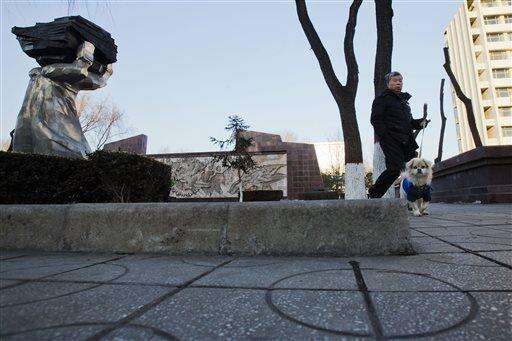
In this Feb. 6, 2015 photo, a man walks his dog near a giant sculpture depicting a hand holding a piece of coal in Gujiao in northern China's Shanxi province. Chinaâs coal production is estimated by its main industry group to have fallen 2.5 percent last year, the first reduction in two decades. Environmentalists welcomed that as a sign coal use might decline, but it prompted unease about the health of an industry that the Ministry of Land and Resources says employs 10.3 million people. (AP Photo/Ng Han Guan)
The Associated Press
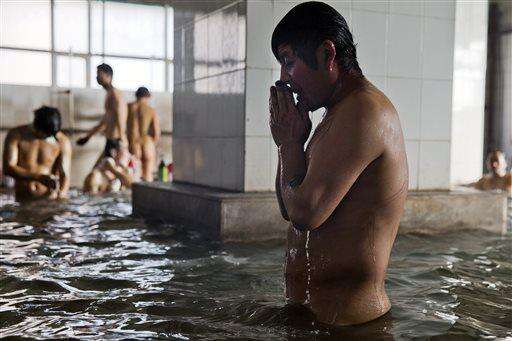
EDITORS NOTE: NUDITY - In this Feb. 6, 2015 photo, coal miners wash up after their eight hours shift at a coal mine in Gujiao in northern China's Shanxi province. Chinaâs coal production is estimated by its main industry group to have fallen 2.5 percent last year, the first reduction in two decades. Environmentalists welcomed that as a sign coal use might decline, but it prompted unease about the health of an industry that the Ministry of Land and Resources says employs 10.3 million people. (AP Photo/Ng Han Guan)
The Associated Press